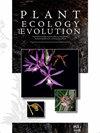用红墨水印刷:巴西大西洋森林中的两个新品种朱顶红(石蒜科)
IF 1.3
4区 生物学
Q3 PLANT SCIENCES
引用次数: 0
摘要
背景和目标——大西洋森林是世界上五个最重要的生物多样性热点之一,是热带地区特有性和物种丰富度最高的地区之一。该地区被认为是朱顶红属的多样性中心,该属由分布在新热带地区的约100个物种组成。由于其大而艳丽的花朵,该属深受世界各地收藏家和园艺家的追捧,数百年来生产和交易了数百种杂交品种。然而,它的大多数物种仍然只从一个或几个种群中知道,有几个被官方认定为濒危物种。对巴西朱顶红属的专题研究揭示了大西洋森林中两个可能的微流行病新种。材料和方法——新物种的形态描述基于植物标本馆标本和栽培植物,以及原位观察。描述和措施是按照标准程序进行的。初步保护评估遵循了国际自然保护联盟的指导方针和标准。关键结果——这两个物种都表现出了朱顶红亚属的典型形态,它们应该被放在其中。它们可以通过几个花的特征与类似的分类群区分开来,包括该属中分布最广泛和已知的一些物种。提供了有关生态学、保护、照片和插图的数据,以及与相关物种的比较。提供了巴西大西洋森林朱顶红物种的识别钥匙,并附有这些物种在其自然栖息地的照片。结论-由于已知位置单一,种群规模较小,这些新物种被认为是极度濒危物种。这些发现加强了在大西洋森林不同区域继续采样的必要性,以及专业分类学家进行系统研究的重要性。本文章由计算机程序翻译,如有差异,请以英文原文为准。
To print in red ink: two new species of Hippeastrum (Amaryllidaceae) from the Brazilian Atlantic Forest
Background and aims – The Atlantic Forest is among the five most important biodiversity hotspots in the world, harbouring one of the highest levels of endemism and species richness in the tropics. The region has been suggested as a centre of diversity for the genus Hippeastrum, which comprises about one hundred species distributed throughout the Neotropics. Due to its large and showy flowers, the genus is highly sought after by collectors and horticulturists around the world, with hundreds of hybrids produced and traded for centuries. However, most of its species are still known from only one or a few populations, and several are officially recognized as endangered. Monographic studies on the genus Hippeastrum in Brazil have revealed two likely microendemic new species from the Atlantic Forest.
Material and methods – The morphological descriptions of the new species are based on herbarium specimens and cultivated plants, as well as in situ observations. Descriptions and measures were taken following standard procedures. Preliminary conservation assessments followed IUCN guidelines and criteria.
Key results – Both species show typical morphology of the subgenus Hippeastrum, in which they should be placed. They can be distinguished from similar taxa, including some of the most widely distributed and known species of the genus, by several floral characters. Data on ecology, conservation, and photographs and illustrations are provided, as well as comparisons with related species. An identification key to the Brazilian Atlantic Forest species of Hippeastrum is provided, accompanied by photographs of these species in their natural habitats.
Conclusion – The new species are considered critically endangered due to their single known location and small population size. The findings reinforce the need for continued sampling across different regions of the Atlantic Forest, as well as the importance of systematic studies conducted by specialist taxonomists.
求助全文
通过发布文献求助,成功后即可免费获取论文全文。
去求助
来源期刊

Plant Ecology and Evolution
PLANT SCIENCES-
CiteScore
2.20
自引率
9.10%
发文量
27
审稿时长
>12 weeks
期刊介绍:
Plant Ecology and Evolution is an international peer-reviewed journal devoted to ecology, phylogenetics and systematics of all ‘plant’ groups in the traditional sense (including algae, cyanobacteria, fungi, myxomycetes), also covering related fields.
The journal is published by Meise Botanic Garden and the Royal Botanical Society of Belgium.
 求助内容:
求助内容: 应助结果提醒方式:
应助结果提醒方式:


